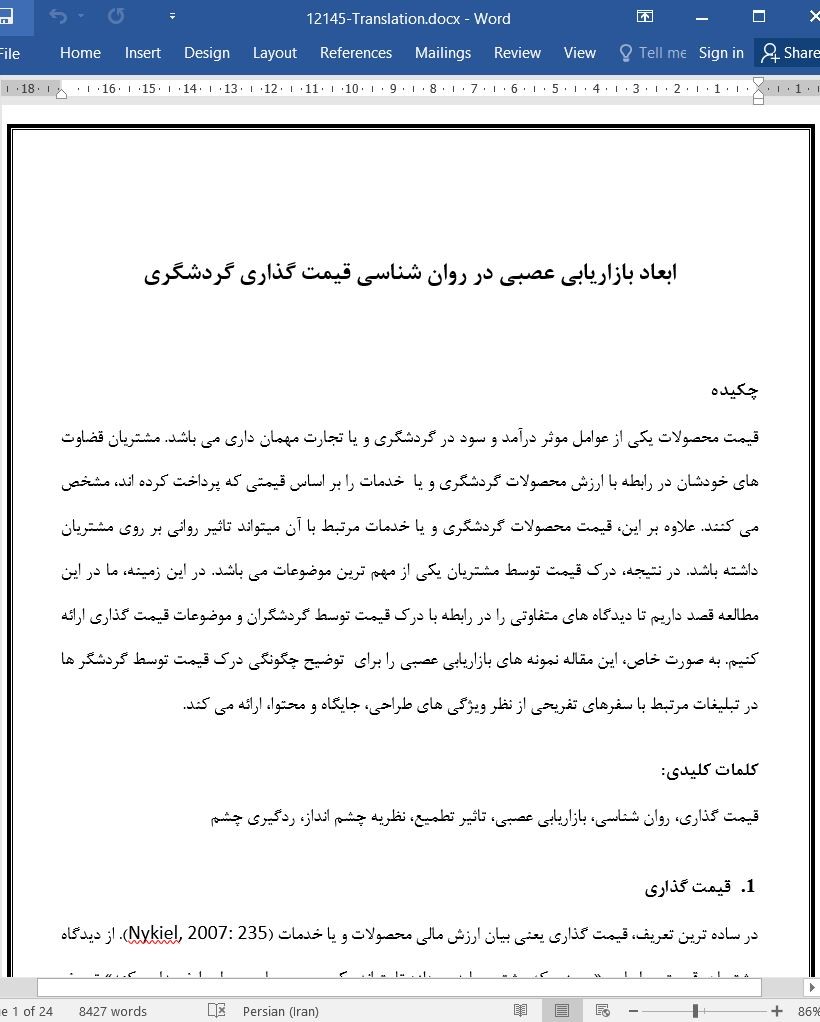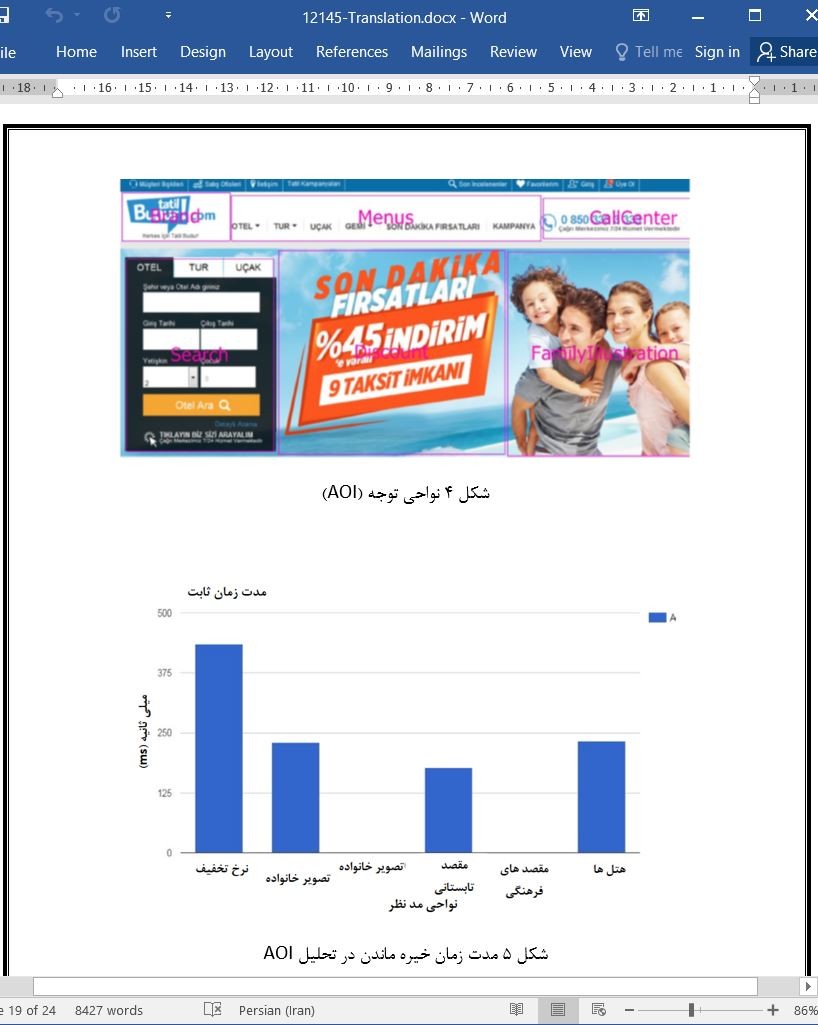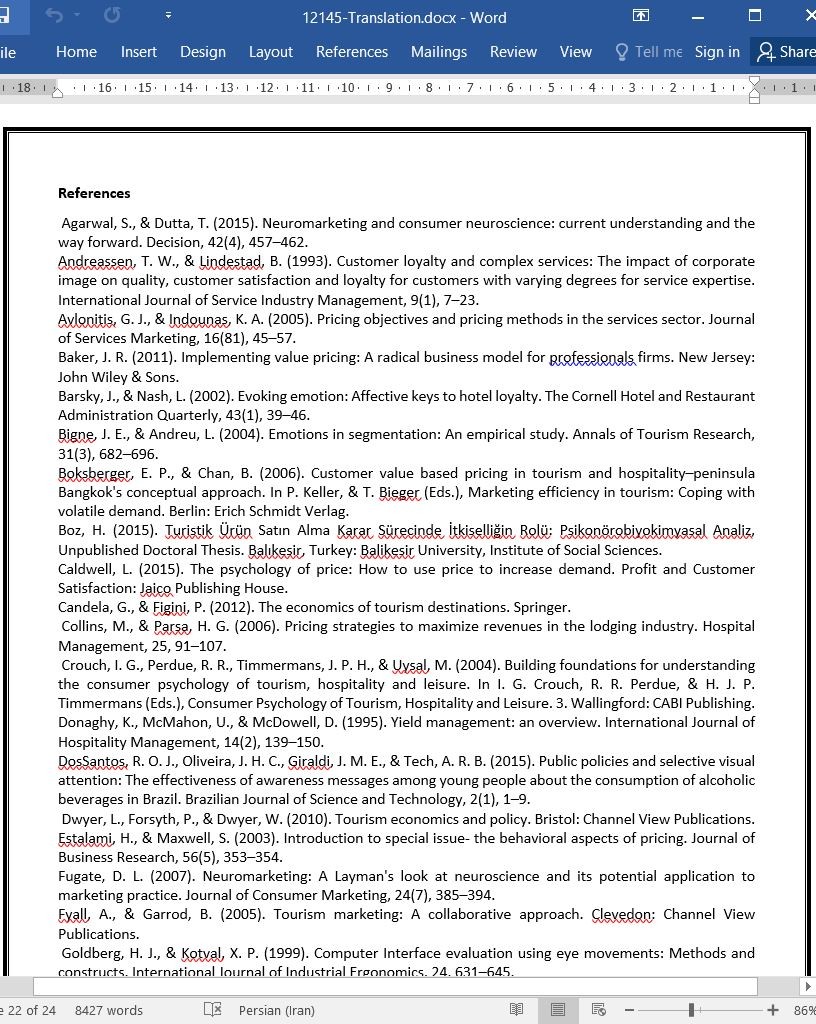
ابعاد بازاریابی عصبی در روان شناسی قیمت گذاری گردشگری
چکیده
قیمت محصولات یکی از عوامل موثر درآمد و سود در گردشگری و یا تجارت مهمان داری می باشد. مشتریان قضاوت های خودشان در رابطه با ارزش محصولات گردشگری و یا خدمات را بر اساس قیمتی که پرداخت کرده اند، مشخص می کنند. علاوه بر این، قیمت محصولات گردشگری و یا خدمات مرتبط با آن میتواند تاثیر روانی بر روی مشتریان داشته باشد. در نتیجه، درک قیمت توسط مشتریان یکی از مهم ترین موضوعات می باشد. در این زمینه، ما در این مطالعه قصد داریم تا دیدگاه های متفاوتی را در رابطه با درک قیمت توسط گردشگران و موضوعات قیمت گذاری ارائه کنیم. به صورت خاص، این مقاله نمونه های بازاریابی عصبی را برای توضیح چگونگی درک قیمت توسط گردشگر ها در تبلیغات مرتبط با سفرهای تفریحی از نظر ویژگی های طراحی، جایگاه و محتوا، ارائه می کند.
1. قیمت گذاری
در ساده ترین تعریف، قیمت گذاری یعنی بیان ارزش مالی محصولات و یا خدمات (Nykiel, 2007: 235). از دیدگاه مشتریان، قیمت بر اساس « چیزی که مشتری باید بپردازد تا بتواند یک سرویس یا محصول را خریداری کند» تعریف می شود. این چیزی که مشتری باید پرداخت کند شامل پول، زمان، تلاش فکری و یا هزینه های تراکنش می باشد (Shoemaker & Mattila, 2009: 536). قیمت بر روی ارزش درک شده توسط مشتریان تاثیر دارد. خریداران معمولا از قیمت به عنوان یک سر نخ ادراکی استفاده می کنند تا بتوانند کیفیت محصول یا خدمت را بررسی کنند. به صورت عموم، کیفیت یک محصول یک تصویر آینه ای از قیمت آن می باشد. ازین رو، تجارت ها می توانند با افزایش قیمت نشان دهنده کیفیت محصولات و خدمات باشند و یا با کاهش قیمت های خودشان، بر روی چانه زنی تمرکز بیشتری داشته باشند (Estalami &Maxwell, 2003; Hoffman, Turley, & Kelley, 2002). به عنوان مثال، هتل Gosforth Park، یک هتل رده بالا در نیوکاسل انگلستان، نشان داد که نرخ استفاده از اتاق های این هتل با افزایش قیمت، بیشتر شده است (Kotler, Bowen, & Makens, 2006).
4. جمع بندی
این مطالعه ابعاد روانی قیمت گذاری را به عنوان یک المان ترکیب بازاریابی، توضیح داده است. نامشهود بودن و ناپایداری خدمات، چالش های بسیار جدی را در رابطه با قیمت گذاری برای مدیران در بخش بیمارستان ایجاد می کند. به دلیل کمبود المان های مشهود خدمات، مشتریان احتمالا اهمیت بیشتری برای قیمت قائل هستند. علاوه بر این، ناپایداری خدمات باعث می شود که برنامه ریزی و مدیریت روز به روز برای مدیران دشوار تر شود .بدون برنامه ریزی و اجرای دقیق برای سیستم های مدیریت بازدهی و تقاضا، مدیران صنعت مهمان داری معمولا مجبور هستند که از طرح های تبلیغات مبتنی بر قیمت استفاده کند. این موضوع به نوبه خودش مانع توسعه تصویر قوی برند شده و در نتیجه باعث می شود که حاشیه سود کمتر در بخش مهمان داری ایجاد شود.
Abstract
The price of a product is the key determinant of the revenues and profits of a tourism or hospitality business. Customers form their value judgments of a touristic product or service based on the price they have paid. Moreover, the price of a touristic product or service may have psychological influences on the customer. Thus, the way prices are perceived by potential tourists is of paramount importance. Against this backdrop, this study aims to provide insight into how tourists perceive prices and pricing issues. In particular, it provides neuromarketing examples to explain how tourists perceive prices in holiday advertisements in terms of design features, positioning and content.
1. Pricing
In its simplest definition, pricing is the monetary value of a product or service (Nykiel, 2007: 235). From the customer's viewpoint, price is defined as ‘what she or he must give up to purchase the product or service’. The ‘what’ may include actual money, time, cognitive effort, and transaction costs (Shoemaker & Mattila, 2009: 536). Price influences customers' perceived value. Buyers often use price as a perceptual cue to infer the quality of a product or service. Traditionally, the quality of a product has been treated as the mirror image of the price. Hence, businesses may emphasize the quality of their products and services by raising their prices and emphasize a bargain by decreasing their prices (Estalami & Maxwell, 2003; Hoffman, Turley, & Kelley, 2002). For example, the Gosforth Park Hotel, an upscale hotel in Newcastle, the UK, found that its occupancy rate increased as their prices increased (Kotler, Bowen, & Makens, 2006).
4. Conclusion
This study has explained the psychological aspects of pricing as a marketing mix element. The intangibility and perishability of services pose significant challenges regarding pricing for managers in the hospitality sector. Due to the lack of tangible elements of services, customers may attach a greater significance to price. Moreover, the perishability of services renders the planning and management of day-to-day operations more difficult for managers. Without well-planned and wellimplemented demand and yield management systems, hospitality managers may often have to resort to price-based promotions. This in turn may prevent the development of a strong brand image and result in even narrower profit margins in the hospitality sector.
چکیده
1. قیمت گذاری
1.1 قیمت گذاری در گردشگری
2. قیمت گذاری های روانی
3. روان شناسی قیمت گذاری در گردشگری
3.1 نحوه استفاده از ابزار بازاریابی عصبی برای تحقیقات در رابطه با استراتژی های بازاریابی در محصولات گردشگری
4. جمع بندی
منابع
Abstract
1. Pricing
1.1. Pricing in tourism
2. Psychological pricing
3. Tourism pricing psychology
3.1. How to apply neuromarketing tools to research on pricing psychology of tourism products
4. Conclusion
References
- اصل مقاله انگلیسی با فرمت ورد (word) با قابلیت ویرایش
- ترجمه فارسی مقاله با فرمت ورد (word) با قابلیت ویرایش، بدون آرم سایت ای ترجمه
- ترجمه فارسی مقاله با فرمت pdf، بدون آرم سایت ای ترجمه



